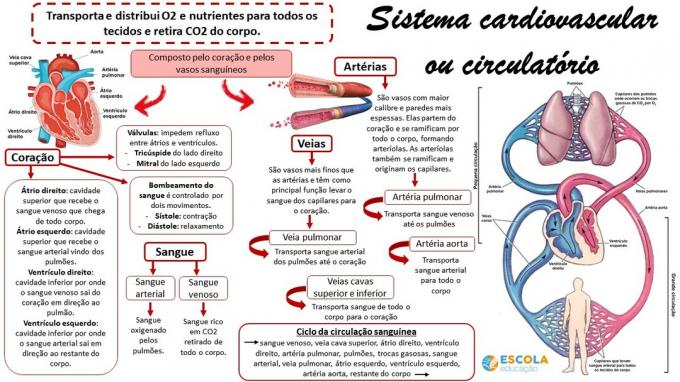O Cardiovascular system it can also be called the circulatory system. It comprises the heart and blood vessels and is responsible for transporting and distributing nutrients and oxygen throughout the body.
In humans, the blood circulation process takes place in two stages: small and large circulation. Therefore, blood passes through the heart twice every complete cycle.
The heart is responsible for pumping blood and blood vessels carry blood throughout the body.
Index
- Heart
- Anatomical structure of the heart
- Blood
-
Blood vessels
- arteries
- veins
- small circulation
- large circulation
- Mental map
Heart
O heart it is a muscular organ that is located in the rib cage, between the lungs. It is noteworthy that, despite the heart being between the lungs, it is not a centralized organ, its position is slightly shifted to the left side.
This organ works like a pump, the right side pumping venous blood to the lungs and the left side pumping arterial blood to the rest of the body.
The pumping of blood is coordinated by muscle movements called: systole (contraction) and diastole (relaxation).
Anatomical structure of the heart
The heart is an organ made up of four cavities:
- right atrium: upper cavity that receives venous blood from all over the body.
- left atrium: upper cavity that receives arterial blood from the lungs.
- right ventricle: Inferior cavity where venous blood exits the heart towards the lung.
- Left ventricle: lower cavity where arterial blood exits towards the rest of the body.
It has two valves between the atria and the ventricles that prevent the blood from returning to the place where it started, they are:
- tricuspid valve: prevents blood reflux on the right side.
- mitral valve: prevents blood reflux from the left side.
In addition, the heart is made up of three layers:
- Pericardium: membranous layer that lines the outside of the heart.
- endocardium: membranous layer that lines the inner part of the heart.
- Myocardium: muscular layer located between the pericardium and the endocardium, responsible for the contractions of the heart.

Blood
Despite being liquid, blood is also a tissue, called blood tissue.
It has a fundamental role in life, as it is responsible for transporting oxygen to cells and removing carbon dioxide from the body.
In addition, it is also responsible for carrying nutrients, hormones and other substances to all other tissues.
Blood vessels
arteries
At arteries they are vessels with larger caliber and thicker walls. They start from the heart and branch out throughout the body.
The branches of the arteries are called arterioles, which also branch out into very thin vessels present in all tissues, called capillaries.
- Free Online Inclusive Education Course
- Free Online Toy Library and Learning Course
- Free Online Math Games Course in Early Childhood Education
- Free Online Pedagogical Cultural Workshops Course
All arteries are extremely important for blood circulation. Two of them are directly involved in the process with the heart, the pulmonary artery and the aorta artery.
veins
At veins they are thinner vessels than arteries and their main function is to carry blood from the capillaries to the heart.
Like arteries, there are several veins in our body and all of them are of fundamental importance for blood circulation.
However, some of them are directly involved in the blood oxygenation process.
The pulmonary veins are responsible for bringing arterial blood from the lungs to the heart. The inferior and superior vena cava, on the other hand, bring venous blood from all over the body to the heart.
small circulation
The small circulation can also be called the pulmonary circulation. This part of the process refers to the entry and exit of blood from the lungs.
Venous blood enters the right atrium, travels to the right ventricle, and then pumps into the pulmonary artery to the lungs.
In the capillaries of the lungs, there is an exchange of carbon dioxide in the blood for oxygen absorbed from the atmospheric air, and the blood is no longer venous and becomes arterial.
Arterial blood leaves the lungs and is taken back to the heart, now in the left atrium, through the pulmonary vein.
large circulation
The great circulation can also be called systemic circulation, as it transports blood from the heart to all the systems of the body and vice versa.
Arterial blood that reaches the left atrium of the heart comes from the lungs through the pulmonary vein.
It is pumped into the left ventricle and leaves the heart through the aorta artery, which is responsible for carrying arterial blood throughout the body.
When arterial blood reaches the other tissues, a gas exchange takes place again, the carbon dioxide present in the tissues is exchanged for oxygen in the arterial blood, transforming it into venous blood.
The venous blood returns to the heart again and the entire circulatory process is restarted.

Mental map
The School Education team prepared a mind map about the cardiovascular system to help you synthesize that content.
You can paste it in your notebook to help you study, enjoy!

Click here to download this mind map in PDF!
See too:
- Mind Map - Cardiovascular or Circulatory System
- Connective Tissues - Bone and Blood
- hematosis
The password has been sent to your email.
